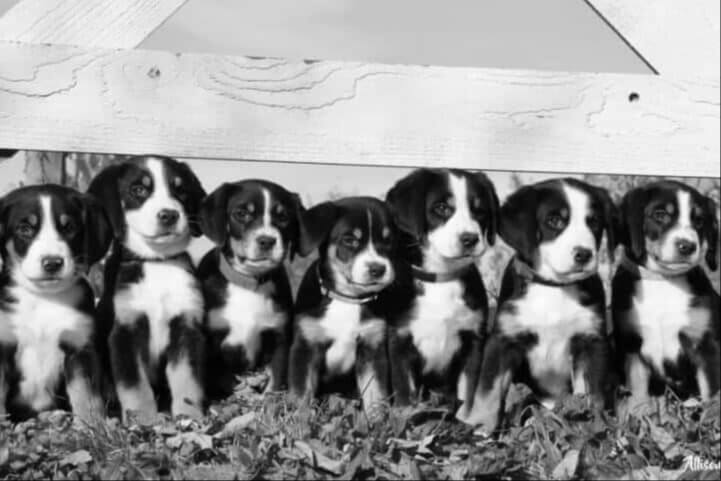
Greater Swiss Mountain Dog
The Greater Swiss Mountain Dog is a powerful, versatile breed known for its history as a draft and drover dog.
Home » Meet The Breeds » Greater Swiss Mountain Dog

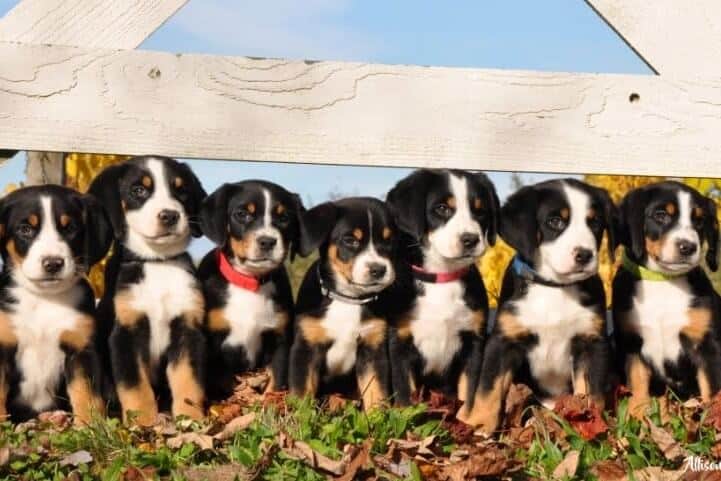
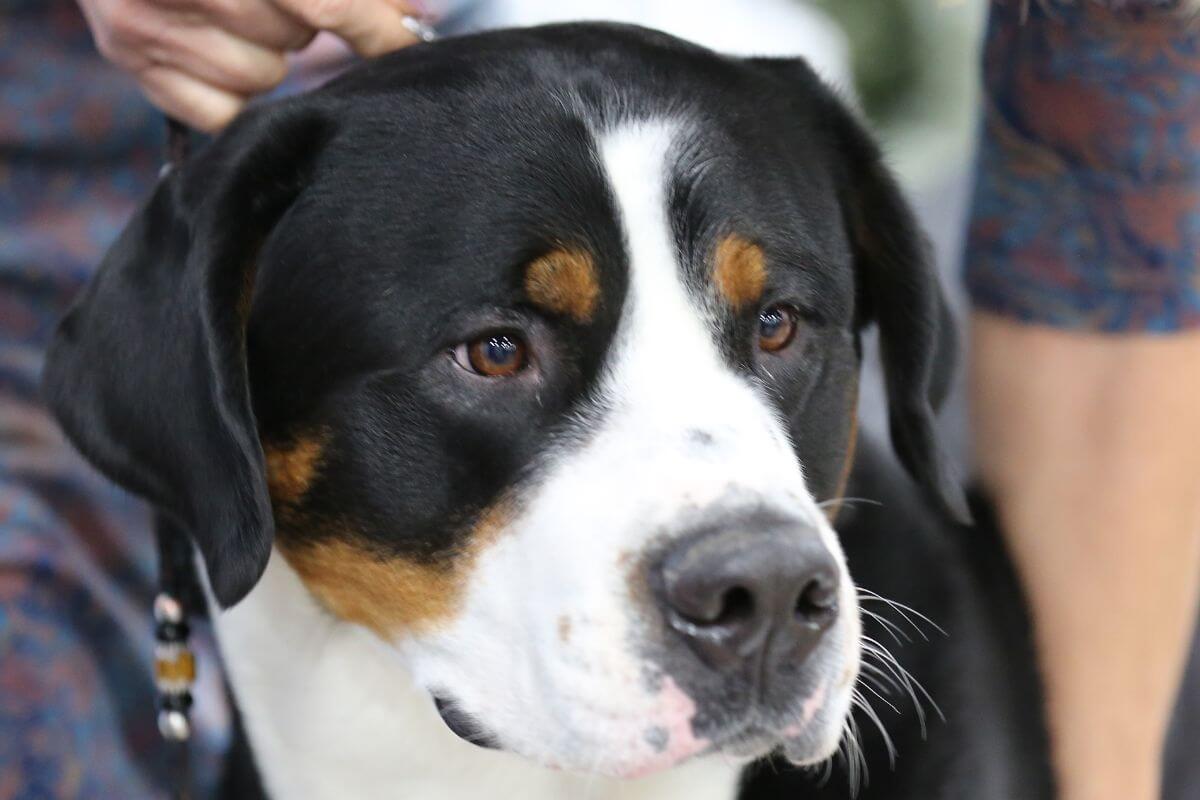
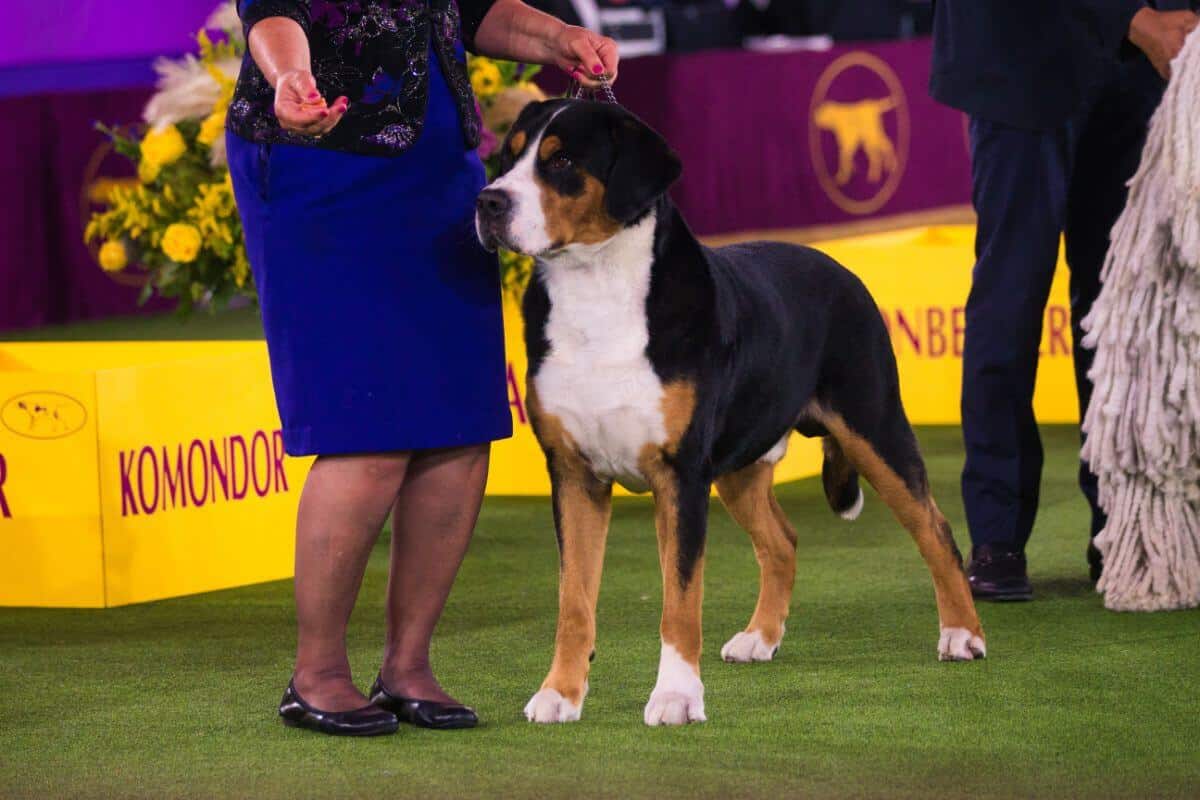
The Greater Swiss Mountain Dog is a large, powerful working breed known for its strength, versatility, and alert temperament. Originating in the Swiss Alps, these dogs were traditionally used as draft animals, drovers, and farm guardians. With their striking tri-colored coat and confident nature, they have become better recognized today as dependable companions and all-purpose farm dogs.
Working
23.7 – 28.5 inches
85 – 140 pounds
8 – 11 years
| Country of Origin | Switzerland |
|---|---|
| Bred For | Guarding, Pulling Loads |
| Known For | Large Size, Strength, Tri-Colored Markings |
| Popularity | Moderate |
| Temperament | Bold, Faithful, Willing |
| Activities | Drafting, Droving, Search and Rescue, Conformation Shows, Dog Sports |
The Greater Swiss Mountain Dog is one of four distinguished breeds of Swiss Sennenhunds. Believed to have descended in part from large mastiff-type dogs brought to the region by Roman legions over 2,000 years ago, these powerful canines became essential working dogs in the Swiss Alps. They were primarily used for pulling carts, guarding livestock, and assisting farmers with daily chores.
By the 19th century, the breed’s numbers had significantly declined due to the increasing mechanization of agriculture and the rise of other working breeds. However, in 1908, Swiss canine expert Albert Heim recognized a large, tri-colored dog at a dog show in Langenthal and identified it as a surviving example of the old Swiss draft dogs. Heim’s efforts helped to revive the breed, leading to its official recognition by the Swiss Kennel Club (Schweizerische Kynologische Gesellschaft, SKG) in 1910.
The Fédération Cynologique Internationale (FCI) later recognized the breed, further establishing its presence in European working dog circles. The Greater Swiss Mountain Dog was officially recognized by the American Kennel Club (AKC) in 1995, classified within the Working Group.
Since its re-establishment, the breed has gained popularity as a versatile farm dog, a family companion, and a competitor in various dog sports. Despite its historical decline, dedicated breeders and enthusiasts have ensured the preservation of the “Swissy,” maintaining its traditional role as a strong, intelligent, and devoted working partner.
Adult male Greater Swiss Mountain Dogs typically stand between 25.5 and 28.5 inches tall at the shoulder, while mature females range from 23.5 to 27 inches. Males generally weigh between 115 to 140 pounds, whereas females typically weigh from 85 to 110 pounds.
The Greater Swiss Mountain Dog is slightly longer than tall, in a ratio of 10 to 9, with a strong and well-balanced body. Its sturdy bone structure and deep chest provide the power necessary for pulling heavy loads, while its level topline and firm back contribute to its stability. The breed’s muscular build and moderate angulation allow for efficient movement, reflecting its heritage as a hardworking farm and draft dog.
Texture: The Greater Swiss Mountain Dog has a double coat that provides protection against harsh weather conditions. The topcoat is dense and measures from 1.25 to 2 inches in length. The thick undercoat is sometimes showing, and may be tawny to dark gray in color. This double coat is adaptable to varying climates, particularly cold mountain regions. Typically, white appears on the chest, running from the throat to the chest, as well as on all four feet and on the tip of the tail.
Colors:
Markings:
A Note About Color: The topcoat is black with rich rust (red) and white markings. Symmetry of markings is desired. On the head, rust typically appears over each eye, on each cheek, and on the underside of the ears. On the body, rust appears on both sides of the forechest, on all four legs, and underneath the tail. White markings typically appear on the head (as a blaze) and muzzle. The blaze may vary in length and width; it may be a very thin strip or it may extend over the top of the skull and meet with a white patch or collar on the neck. Any color other than tri-colored black, red, and white as described is a disqualification in the show ring.
The Greater Swiss Mountain Dog has a long, thick tail that reaches at least to the hocks. At rest, the tail is carried low, hanging naturally. When the dog is alert or in motion, the tail is slightly raised but never curled over the back. The tail is covered with the same short, dense coat as the rest of the body, maintaining the dog’s natural and balanced appearance.
Owning a Greater Swiss Mountain Dog requires careful consideration due to the breed’s size, strength, and working heritage. The Swissy thrives in active households where it can receive proper training, exercise, and companionship. While affectionate and loyal, the breed needs a dedicated caretaker who understands its needs and is willing to invest time into socialization and obedience training.
The Greater Swiss Mountain Dog is generally a sturdy and healthy breed, but like all large dogs individuals can be prone to certain health concerns. With proper care, a Swissy typically lives between 8 and 11 years. Responsible breeders conduct health screenings to minimize the risk of inherited conditions, but prospective owners should be aware of common issues that can affect the breed.
The most common health concerns in the Greater Swiss Mountain Dog include:
The Greater Swiss Mountain Dog is confident, loyal, and affectionate but not ideal for novice owners due to its size and independent nature. Strong bonds with family members can cause them to dislike being left alone for prolonged periods. While friendly, they can be reserved with strangers and have natural watchdog instincts.
Swissies are generally good with other dogs and patient with children, though supervision is necessary due to their large size. They are intelligent but can be stubborn, responding best to firm yet positive training. Early socialization is key, and consistent leadership, praise, and rewards help to guide their somewhat strong-willed nature.
Swissies need a high-quality diet that supports their large build and energy levels. Puppies require large-breed formulas to promote steady growth and prevent joint issues. Adults typically eat 4 to 6 cups of dry food per day, split into two meals. Overfeeding should be avoided, as obesity and bloat are concerns.
Fresh water should always be available, and slow-feed bowls can help to prevent rapid eating. Treats should be given in moderation, and toxic human foods like chocolate, onions, and grapes must be avoided.
Swissies are intelligent but can be stubborn, making early, consistent training essential. They respond best to firm, positive reinforcement. Their natural watchdog instincts may lead to frequent barking, so teaching a “quiet” command can be helpful for managing this tendency.
Leash training is crucial, as the Swissy’s carting heritage can be expressed in a strong instinct to pull. Mental stimulation is just as important as physical exercise, so it’s important to provide a job for the dog to perform. With proper training and socialization, any dog can become a well-mannered companion and excel in activities like Obedience, Carting, and Weight Pull.
The Greater Swiss Mountain Dog has moderate exercise needs but requires regular activity to stay healthy and prevent boredom. Daily walks combined with playtime or light work, such as pulling a cart or participating in dog sports, help to keep these big dogs engaged. While they enjoy physical activity, they are not an overly high-energy breed and do not require intense exercise like some other working dogs.
| Energy Level | Moderate to High |
|---|---|
| Exercise Requirements | 1 Hour/Day (Minimum), Daily Walks, Vigorous Running, Regular Exercise, Mental Stimulation |
Despite their working background, Swissies are known for being somewhat slow to mature and may exhibit clumsy behavior as young adults. They love spending time with their owners and do best when exercise includes interaction, such as hiking, obedience training, or structured play. They should, however, not be overexerted in hot weather due to their thick double coat.
Swissies have a short, dense double coat that sheds year-round, with heavier shedding in spring and fall. Weekly brushing helps to remove the loose hair and maintain overall coat health, while more frequent brushing is needed during seasonal shedding periods.
| Coat Type | Dense, Medium Length |
|---|---|
| Grooming Requirements | Weekly Brushing, Occasional Bathing, Routine Ear Cleaning, Periodic Nail Trimming, Regular Tooth Brushing |
Bathing is only necessary occasionally, as the Swissy’s coat naturally repels dirt. Routine care, including ear cleaning, nail trimming, and dental hygiene, is essential to keep the dog comfortable and healthy. The breed’s short coat is easy to maintain, but its size makes grooming tasks, such as nail trimming, more challenging without early acclimation.
The Greater Swiss Mountain Dog can adapt to various living situations but thrives in homes with plenty of space to move. While they can live in apartments if given enough exercise, they do best in homes with access to a fenced yard. Their thick coat makes them well-suited for cold weather, but they are sensitive to heat and should have access to shade and fresh water in warmer climates.
Swissies become deeply attached to their families and do not like being left alone for prolonged periods. They are naturally alert and may bark to signal unfamiliar activity, making them excellent watchdogs. A structured routine, proper training, and consistent companionship help them remain happy and well-adjusted as adult companions.
Greater Swiss Mountain Dog puppies require patience, consistency, and a commitment to proper training and socialization. These pups grow quickly but mature slowly, both physically and mentally. Early training and guidance are essential to make sure they develop into well-behaved adults. Due to their size and working heritage, Swissy puppies need structured routines, careful feeding, and controlled exercise to promote healthy development.
Bringing home a Greater Swiss Mountain Dog puppy requires preparation. A safe, designated space will help the pup settle in comfortably. Crate training is recommended to aid housebreaking and provide a secure resting place. Early socialization with different people, environments, and experiences helps to build confidence and can prevent timidity or excessive suspicion toward strangers.
Feeding should follow a controlled schedule with a large-breed puppy formula that will support slow, steady growth and reduce the risk of joint problems. Overfeeding or excessive calcium intake can contribute to orthopedic issues, so portions should be carefully measured. The Swissy pup should be fed three to four small meals a day until around six months of age, then transitioned to two meals per day.
Exercise must be carefully managed. While the Swissy puppy is typically active and playful, excessive running and jumping, or rough play, can strain developing joints. Short, supervised walks and light play sessions will provide appropriate activity without overexertion.
Early training should focus on basic obedience, leash manners, and impulse control. The Swissy pup is intelligent but can be stubborn, so consistent positive reinforcement works best. Teaching commands like “sit,” “stay,” and “leave it” early on helps to establish good behavior. Gentle but firm guidance is essential, as this pup quickly grows into a large and strong adult.
Regular veterinary checkups, vaccinations, and parasite prevention are crucial in the first year. Routine handling—such as brushing, nail trimming, and ear cleaning—should start early to help the puppy become comfortable with grooming as it grows.
The Greater Swiss Mountain Dog is recognized by the world’s leading registries and kennel organizations, which categorize the breed into a specific Group based on its unique characteristics. This breed is recognized worldwide under the following Group designations:
| Organization | Group Designation |
|---|---|
| AKC (American Kennel Club) | Working |
| UKC (United Kennel Club) | Guardian |
| CKC (Canadian Kennel Club) | Working |
| ANKC (Australian National Kennel Council) | Utility |
| RKC (The Royal Kennel Club) | Working |
| FCI (Fédération Cynologique Internationale) | Group 2: Pinscher and Schnauzer Molossoid Breeds – Swiss Mountain and Cattle Dogs; Section 3: Swiss Mountain and Cattle Dogs |
The ideal Greater Swiss Mountain Dog is described by a Breed Standard that is approved by each of the world’s leading registries and kennel organizations. The Breed Standards for this breed may be found in the following links:
| Organization | Breed Standard |
|---|---|
| American Kennel Club | AKC GSMD Breed Standard |
| United Kennel Club | UKC GSMD Breed Standard |
| Canadian Kennel Club | CKC GSMD Breed Standard |
| Australian National Kennel Council | ANKC GSMD Breed Standard |
| The Royal Kennel Club | RKC GSMD Breed Standard |
| Fédération Cynologique Internationale | FCI GSMD Breed Standard |
While the Greater Swiss Mountain Dog is not a common breed, some individuals may find themselves in need of a new home due to changes in their owners’ circumstances. Breed-specific rescue organizations help to rehabilitate and rehome dogs in need, ensuring they are placed in suitable, experienced homes.
Yes, Greater Swiss Mountain Dogs shed year-round, with heavier seasonal shedding in the spring and fall. Regular brushing helps to manage the loose hair and keeps the coat healthy.
No, Greater Swiss Mountain Dogs are not hypoallergenic, as they have a dense double coat that sheds regularly. Allergy sufferers may struggle with dander and shedding from this breed.
Greater Swiss Mountain Dogs typically live between 8 and 11 years, depending on genetics, diet, and overall care. Maintaining a healthy weight and providing regular vet check-ups can help to maximize a dog’s lifespan.
Yes, Greater Swiss Mountain Dogs are affectionate, loyal, and great with families, especially when raised with children. However, due to their size and strength, supervision is recommended around smaller kids.
Yes, Greater Swiss Mountain Dogs are naturally alert and will bark to signal unfamiliar activity or visitors. Early training can help to manage any excessive barking while maintaining the dog’s protective instincts.

The Greater Swiss Mountain Dog is a powerful, versatile breed known for its history as a draft and drover dog.

Learn how to judge the Greater Swiss Mountain Dog, focusing on size, structure, temperament, and movement.

Explore the history, resilience, and rise of the Greater Swiss Mountain Dog, a loyal Swiss working breed turned beloved family pet.

The base coat color of the Greater Swiss Mountain Dog is always black with tan points; white feet, chest, tip of tail, muzzle, and blaze.
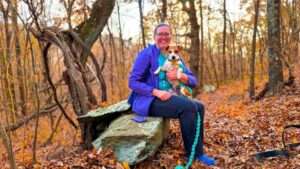
Martha Tubman is the breeder behind the Swallowfield. Read about the kennel’s beginnings, the champions, the puppies, and much more!
The best way to ensure a long and happy relationship with a purebred dog is to purchase one from a responsible breeder. Not sure where to begin?
Contact the National Parent Club’s Breeder Referral Program, which is listed on the AKC Breeder Referral Contacts page.
